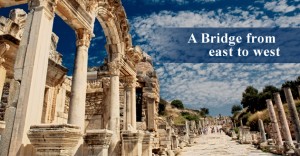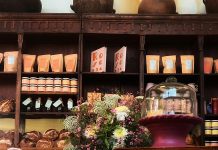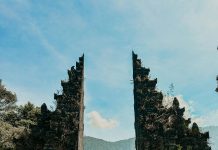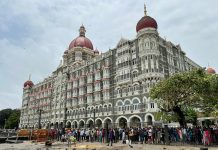 Given the history of Turkey, first as part of the Greek and Roman empires, then the Byzantine empire, the Ottoman empire, and now finally a democratic republic, there are a range of awe-inspiring architectural marvels in the country. On a trip here, one must buy some gorgeous pottery, feel the mystical Sufidervish dances, try flavoured hookahs in oriental splendour, lounge in a Roman natural bath and dine under the bridge connecting Asia to Europe over the Bosporus.
Given the history of Turkey, first as part of the Greek and Roman empires, then the Byzantine empire, the Ottoman empire, and now finally a democratic republic, there are a range of awe-inspiring architectural marvels in the country. On a trip here, one must buy some gorgeous pottery, feel the mystical Sufidervish dances, try flavoured hookahs in oriental splendour, lounge in a Roman natural bath and dine under the bridge connecting Asia to Europe over the Bosporus.
Goreme, Cappadoccia
After spending a short night in Istanbul we flew out straight away to Cappadoccia to a lovely town called Goreme. This region is famous for its rock cave houses and deep tunnels, some over two millennia old and seven stories underground. Our ‘rock cave’ hotel made for an enjoyable experience and was fully equipped with modern amenities like a Jacuzzi. The natural landscape is unique in the world and best enjoyed with an early morning hot air balloon ride. Take a jeep tour around the region to see these unique rock formations. Another must-see is the Goreme National Park that has hundreds of churches that were built and painted by monks who found refuge in these natural caves. The depictions of Christ and the Virgin Mary are unique and representative of this period’s artistic style.
Selcuk and Ephesus
From Keyseri Airport in Cappadoccia, we flew to Izmir and travelled to Selcuk, where the Virgin Mary is supposed to have spent her last days with St John. Mary’s Grotto at Selcuk has a calm peace that soaks through the area. St John’s Basilica hints at the magnificent church that must have once stood over it. The highlight of the region’s treasures is a visit to the archaeological remains of Ephesus, an ancient Greek city that later become one of the second largest cities after Rome in the Roman Empire. The library of Culsus, the giant amphitheatre capable of holding 25,000 spectators, the temple of Hadrian, the pillared high street and mosaic walkway, and even the public bathrooms will leave you marvelling at the history that is brought alive by the magnificent architecture and sculptures. A number of artefacts found in Ephesus have been moved to the museum at Selcuk to protect them from wear and tear. Also consider a day trip to see the historical cities of Priene, Miletus and Didyma. After some busy sightseeing, round off the day with a trip to the local Hamam, a traditional Turkish bath.
Pamakkule
Another must-visit on the itinerary wasa day trip to Pamakkule to see Heiriapolis, an ancient Roman city with gorgeous natural baths. Calcite-heavy waters have created an unreal landscape of petrified waterfalls and white terraced pools. The landscape has inspired the name of Pamakkule, which literally means ‘cotton castle’. Moreover, it has been proven that the water from the natural baths has healing properties against many diseases.
Istanbul
We spent five days in Istanbul, which was just about enough to see all the attractions in this bustling city, the only one in the world to span two continents. We stayed in Sultanahmet on the European side of the Bosporus, the olden part of Istanbul and the best base for sightseeing in the city. Famous sights in the city include the Byzantine-era Ayasofya or Hagia Sophia, the Blue Mosque, the opulent Topkapi palace and ornate Topkapi harem buildings, the over-the-top Dolmabahçe palace.
The Grand Bazaar in Istanbul is the world’s largest covered market and one of the oldest. Walking through the labyrinth of shops was a pleasure on its own, but some beautiful, blue, handpainted Turkish lights caught my eye. The silver jewellery too is also of lovely craftsmanship.
Day or night, one can roam the popular Istiklal Caddesi street; a modern district ull of cafes, cinemas, bars and shops. There is an old tramway car that clanks along the centre of the street every 20 minutes, which makes for a fun ride.
Club Reina is recommended for partygoers; it’s a huge complex with multiple restaurants and dance floors and a lovely view of the Bospororus. Rock the night away with the eclectic, young and beautiful crowd of Istanbul.
On our last evening in the city, we went across the river to the Asian side to eat at Ortakoy. We sat at the House Café on the banks of the river underneath the bridge that spans east and west and enjoyed the feeling of being in between two continents.
Flights: You will land at the Atatürk International Airport (IST). Airport transfers are expensive and will waste a precious day if you are flying to other parts of the country from the Sabiha Gökçen International Airport (SAW), which is on the Asian side of the Bosporus.
Hotels: Our experience with a range of hotels, from budget hostels to midrange hotels, was relatively good. They were all impeccably clean and modestly comfortable. Most hotel owners will try to set up tours for you but be sure to find out the local rates before you agree to anything.
Getting Around: The bus services in Turkey are comfortable, even for long journeys. There is usually a movie playing and some have free WiFi for passengers.
Volume 1 Issue 3































